Down Below We Go – Travel in the Copper Queen Mine
Posted in Adventure, Arizona, Family Fun, Historic, Mine Tour, Mountains, Science, Southwest, Travel | By Shelley Gillespie | Tags: Adventure, Arizona, Copper Queen Mine, Historic, Mine Tour, Southwest, Travel
We thought for a long time about whether we wanted to go below to experience what it was like in the mines of Bisbee. The Copper Queen Mine offers tours to recreate a miner’s experience during the over 60 years (1877-1943) the mines were open to find – guess what – copper.
Traveling means you go everywhere and try everything –for our readers.
Without a mine tour, we figured we weren’t experiencing Bisbee at its most memorable. So, we joined a tour. Advanced reservations are suggested as once the tour trolley is full, you must wait for another trip. With five trips daily, there is lots of opportunity to have this experience.
Preparing for the experience
Once you’ve paid your money ($13 for adults, $5.5 ages 4-12), you receive a small, pin-on medallion. When it’s time for your tour, you line up and get suited up. Everyone – everyone the smallest child – receives a heavy yellow rain slicker and a lamp they wind around you so you don’t lose it. (It’s best to leave large and heavy bags behind. Sturdy shoes would be a good idea.) Once you’re suited up, you tramp outside and get on a trolley that you straddle. It isn’t fancy, but probably it’s a lot nicer than what the miners had.
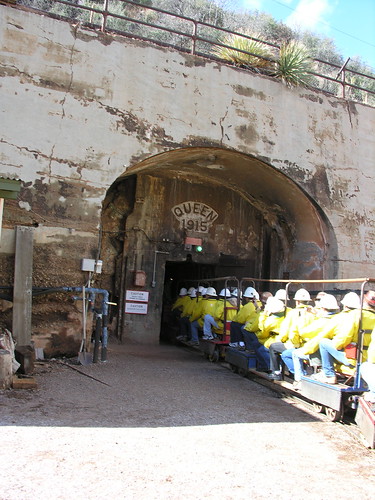
Suited up and ready to go below
Time to go below
The several-car trolley moves on its track to the opening of the mine, curving as it heads into the darkness. It is cold and forbidding the moment you can no longer see daylight. Miners, who worked 8-10 hour shifts, did not see a lot of daylight. The extravagant amount the miners earned at most: $12.30 per shift (not hour!)
Our tour guide Steve kept us together and filled us in on what life was like for miners, how the metals were extracted and housekeeping issues.
Life in the Mines
Actually, in the Copper Queen area there were two mines, the open pit mine that was exposed for all to see, and the Copper Queen that includes 260 miles of tunnels. Mine shafts are horizontally placed at 100-ft intervals. Without lights, it is BLACK as night. Early on, candles were the light source and, according to Steve, 5-7 candles were needed for each miner’s shift. Two shifts were worked each day. (In the mills and smelting, once the ore was extracted, three shifts tackled that effort.)
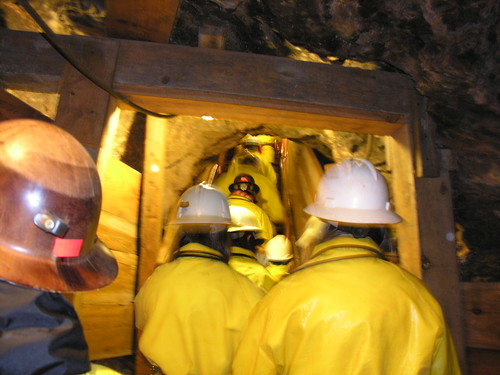
Trooping up stairs to a cavern area
The massive effort was responsible for over 8 billion lbs of copper being extracted from the mine. By products included zinc, lead, and silver.
The miners did not use canaries to gauge air quality. Rats and cockroaches would let them know if cave-ins or poor air quality was an issue. Still, many miners developed silicosis, a disease that cause lung problems. Steve, our tour guide, told us he worked in the mines, but not for long. He went back to school, earned a degree in mining, and improved his status in life. Being a tour guide, he now goes underground regularly.
In the early mining years, tools were more rudimentary. Dynamite, which was produced in nearby Benson at the Apache Powder Company, was used to blow holes in the walls. Timber was used to prop up areas and support the walls.
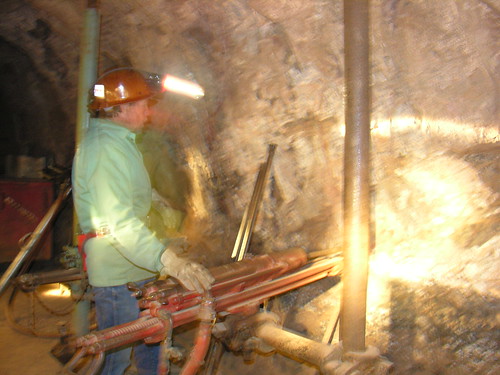
Steve show how the drills worked
Interestingly, miners had an elaborate procedure for placing the dynamite, which was only done at the end of a shift. They had an intricate way they set up the dynamite at distances and amounts for the explosions and safety procedures in place. Since it took 40 seconds for a blast to go off, they could judge when to get out of the way. If a blast did not go off, they notified the next shift so they could be alert for it. Phones were in the mines for emergencies that were hooked to both the local hospital and the mine office, so quick action could be taken to save anyone injured.
An elaborate system of bells was also used to let others know where people were in their rudimentary elevators that traveled between shafts. Five bells meant they were ready to blast, an important warning.
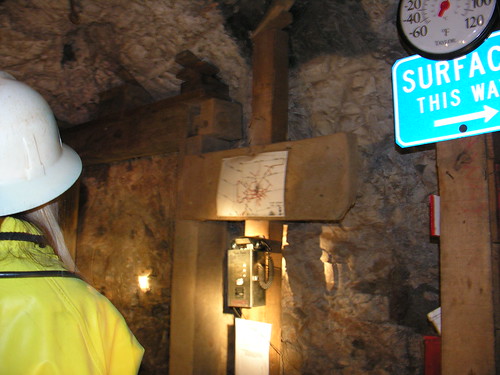
A map showing the mine tunnel locations - and the way out
With their precautions, purportedly only 14 were killed in cave-ins.
Still, it was not a fun life. “Bathrooms” were “two-seater honeypots,” chambers fastened to a wagon that could be hauled away and dumped. Steve said he never saw two people on the honeypot at the same time.
To make a point about how dark the mine is without lights, Steve had everyone turn off the lights for a moment. Not just dark, it was profoundly black, damp and scary. We rapidly turned our battery-operated lights on again.
What did miners do if their lights went out and they wound up alone (miners did work in pairs)? They moved along feeling for the tracks that carried the ore out, following its path until they could get out. Not a situation anyone would relish.
Sadder than the miners’ lives underground was that of the mules used to haul the ore. They never came up from underground for years! When they were finally brought to the surface, they were close to blind and had to be gradually acclimated to light again.
According to one Bisbee local, the miners trudged up the hills, after a long day in the mines, to their homes that had no running water and no electricity.
Out again
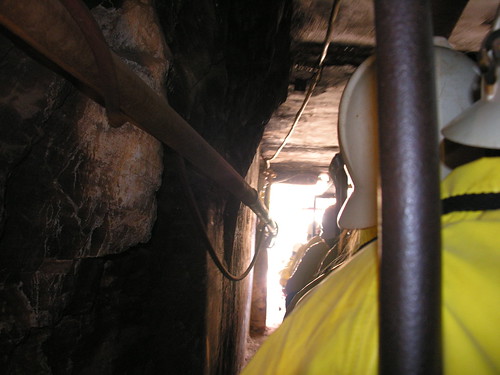
Back to daylight
When we finally came back to daylight again, it was liberating. We had been 1,500 feet into the mine. An interesting experience, we were glad that we were not miners.
Surrendering our slickers and lights back in the tour office, we were glad to be back above ground again.
A shop with geodes and other possible rock purchases is available, plus a min-museum showing some of the tools and history of the mines.
Every time we see a copper penny or pipes, we will remember how that copper came to be used for that purpose. The miners, in essence, made modern life possible.
Later this week…shopping around Bisbee.
Tags: Adventure, Arizona, Copper Queen Mine, Historic, Mine Tour, Southwest, Travel
